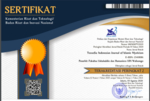class Author Guidelines
The editors invite experts, practitioners, and enthusiasts in Islamic Mysticism to submit research articles. These should be original, research-based, unpublished, and not under review for possible publication in other journals. All submitted papers are subject to review by the editors, editorial board, and blind reviewers. Submissions that violate our guidelines on formatting or length will be rejected without review.
General Instructions
- Articles should be formatted according to the writing pattern of scientific journals. The rules set out in the Chicago Manual of the Style 17th edition (full note) should be followed. You may use Mendeley or Zotero reference management software, and select the setting for the Chicago Manual of the Style 17th edition. For an explanation of the Chicago Manual of the Style 17th edition, please see Chicago Manual of the Style 17th edition (Link)
- Articles should be original works, not previously published in any printed or online journal.
- When the status of the submission (article) is under review or has been published for this journal, the author(s) will not be allowed to submit the article to another journal.
- Submit the article to the editors online via the Open Journal System (OJS).
- The Times New Arabic font (12 pt) should be used, 1.15 spacing, in Microsoft Word format with an B5 page size (160 x 240 mm). The number of words should be between 6000 and 8000 including abstract, tables, references, and figure.
Particular Instructions
- The article should be the result of research in Islamic mysticism (tasawuf and Sufism studies).
- Because of the "Blind Review" system, authors should not include their name, their affiliation, the address of the affiliation, or their email address on the cover of the article. Authors’ names, names of institutions, and email addresses are listed at the time of registration on the OJS author page. Please also give your telephone number when you send your article so that we can contact you easily.
- The content and guidelines of articles should be in narrative essay format, written in paragraphs, and should include these components:
Title
- The title of the manuscript should be on the top of the first page aligned to center. The title should not exceed 15 words in 15-point font, bold, and uppercase. The second title, if any, is capitalized in each word. The title must be informative and written concisely and clearly, not allowing multiple interpretations. It should appropriately reflect the topic.
- The title of the article does not contain unusual abbreviations.
- The main idea should be written on the first title and followed by the subtitle.
Author Name and Affiliation- The author’s name (without academic degree) and the author’s affiliation address and email should also be aligned to center and placed below the article’s title.
- The author’s title and name should be double spaced, followed by the author’s affiliation address and the abstract title (triple spaced).
Abstract
The abstract must be written in one paragraph, italic style, in 12-point font, single spaced, between 150-300 words. The abstract should not be identical with the introduction or the conclusion. It should contain: (1) the main question and the background of the discussed issue; (2) the research position; (3) how the question is discussed in the paper; (4) the method of research, and (5) the main finding of the study and its contribution.
Keywords
The Keywords must be
- Placed below the abstract
- Put in alphabetical order
- Separated by a semicolon
- Limited to three to five words
Introduction
The introduction includes: 1) background of the study, 2) Related studies, 3) research question, 4) research method. All these aspects must justify the research work. In the final part of introduction, the purpose of the paper should be stated.
Discussion and Result
Discussion and results are presented in the same part and should follow a logical structure, from the main result to the supporting, and involve discussion. Any figures and tables should be include in the same section and properly edited by the layout editors.
It is possible to add sections. One section may consist of several sub-sections, typed in bold-italic, and numbered as shown in the following example.
1. Sub-Section as Part of Parent Section
There is need to add any special indentation when typing the body text under the sub-section heading.
2. Another Sub-Section
Adding any further sub-sections is not recomended. Instead, the discussion adn explanation should be structured in consecutive, unnemberd paragraphs.
3. Figure and Illustrations
Any table, figure, image, or illustration to be included require high-resolution picture file submitted as an attachment to the manuscript file.
Conclusion
The conclusion should answer the research questions and not merely restate the discussion and result. It should be a critical summary of the research results. Scientific reflection should also contain suggestions related to further research.
References
The references in the manuscript must be as follows:
- The minimum number of references used is 20.
- The manuscript must use primary sources (75%),
- Personal and other private websites are not allowed.
- The references are arranged by using reference manager Mendeley or Zotero, in the Chicago Manual of the Style 17th edition (full note).
The Reference Quotation Examples
A. Books
Footnote
Arthur John Arberry, An Introduction to the History of Sufism (London: Orient Longman, 1942), 9.
Garland Cannon, The Life, and Mind of Oriental Jones (Cambridge: Cambridge University Press, 1991), 27.
Al-Junaid Imam Abu Al-Qasim, Rasail Junaid, edt. Ali Hasan Abdul Qadir (Cairo: Bura’i dan Geddawi, 1988), 9.
Bibliography
Arberry, Arthur John. An Introduction to the History of Sufism. London: Orient Longman, 1942.
Cannon, Garland. The Life, and Mind of Oriental Jones. Cambridge: Cambridge University Press, 1991.
Al-Qasim, Al-Junaid Imam Abu. Rasail Junaid, edt. Ali Hasan Abdul Qadir, Cairo: Bura’I dan Geddawi, 1988.
NOTE - For multiple authors up to 10 sholud be listed. For more tah 10 authors (not shown here), the first seven authors are listed followed by et al. In the footnore only the first author is listed followed by et al.
B. Book Section
Footnote
William Biddulph, “The Travels of Certain Englishmen,” in Early Modern Tales of Orient, edited by Kenneth Parker (London, New York: Routledge, 1999), 7.
Michel Boivin, “Knowledge, Sufism, and the Issue of a Vernacular Literature,” in The Sufi Paradigm and the Makings of a Vernacular Knowledge in Colonial India (Cham: Springer International Publishing, 2020), 95-113. https://doi.org/10.1007/978-3-030-41991-2_4
Bibliography
Biddulph, William. “The Travels of Certain Englishmen.” In Early Modern Tales of Orient, edited by Kenneth Parker. London, New York: Routledge, 1999.
Boivin, Michel. “Knowledge, Sufism, and the Issue of a Vernacular Literature.” In The Sufi Paradigm and the Makings of a Vernacular Knowledge in Colonial India, 95–113. Cham: Springer International Publishing, 2020. https://doi.org/10.1007/978-3-030-41991-2_4
C. Journal Article
Footnote
Ahmad Gholi, “Reiteration of Prophet Muhammad’s Myths in Biddulph and Cartwright’s Travelogues,” Mediterranean Journal of Social Sciences 7, no. 1 (2016): 251–58. https://doi.org/10.5901/mjss.2016.v7n1s1p251
Atif Khalil and Shiraz Sheikh. “Sufism in Western Historiography: A Brief Overview,” Philosophy East and West 66, no. 1 (2016): 194–217. https://doi.org/10.1353/pew.2016.0022
Bibliography
Gholi, Ahmad. “Reiteration of Prophet Muhammad’s Myths in Biddulph and Cartwright’s Travelogues.” Mediterranean Journal of Social Sciences 7, no. 1 (January 5, 2016): 251–58. https://doi.org/10.5901/mjss.2016.v7n1s1p251
Khalil, Atif, and Shiraz Sheikh. “Sufism in Western Historiography: A Brief Overview.” Philosophy East and West 66, no. 1 (2016): 194–217. https://doi.org/10.1353/pew.2016.0022.
D. Translated Book
Footnote
Abu al-Qasim al-Qushayri, Al-Qushayri’s Epistle on Sufism. Translated by Alexander Knysh (UK: Garnet Publishing Limited, 2007), 17.
Bibliography
al-Qushayri, Abu al-Qasim. Al-Qushayri’s Epistle on Sufism. Translated by Alexander Knysh. UK: Garnet Publishing Limited, 2007
E. Thesis
Footnote
Thoha Hamim, “Moenawar Chalil’s Reformist Thought: A Study of an Indonesian Religious Scholar 1908-1961” (Ph.D. Thesis, McGill University, Montreal, 1996), 145-46.
Bibliography
Hamim, Thoha. “Moenawar Chalil’s Reformist Thought: A Study of an Indonesian Religious Scholar 1908-1961”. PhD diss., McGill University, Montreal, 1996.
Steps for Submitting Manuscripts
The manuscript text submission must follow these steps:
- Register as author using the “Register” botton.
- After the registration is completed, log in as author then click on the “New Submission” menu. The article submission process consists of five stages, namely: (1). Start, (2). Upload Submission, (3). Enter Metadata, (4). Upload Supplementary Files (if any), (5). Confirm.
- In the “Start” menu, choose "Journal Section (Full Article)" and complete the checklists.
- On the “Upload Submission” page, upload the manuscript files in Ms.Word format.
- On the “Enter Metadata” page, fill in the author(s) data and affiliation(s), including the Journal Title, Abstract, and Keywords.
- On the “Upload Supplementary Files” page, upload any supplementary files, copyright transfer agreement, etc.
- On the “Confirmation” page, click “Finish Submission” one checked that the entered information is correct.
If you encounters any difficulties in the submission process through the online system, please contact teosofia@walisongo.ac.id





.png)


